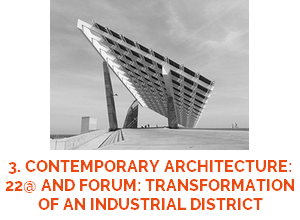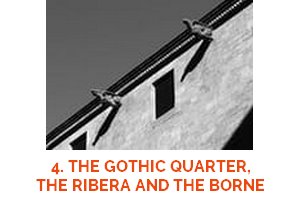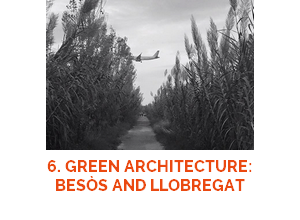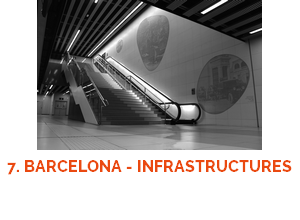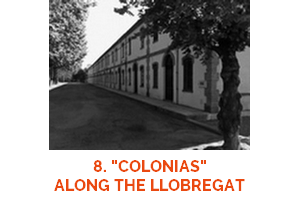
Choose your WALK
Immerse yourself in Barcelona's architecture through our city-architecture walks, designed by experts who are part of the architectural scene and who guide you throughout the circuit.

We visit Barcelona's architectures of reference, public spaces and architecture professionals in this, key city in southern Europe's aesthetics.

We can guide you in:
Spanish, English, French, German, Italian, Portuguese, Chinese and Japanese.

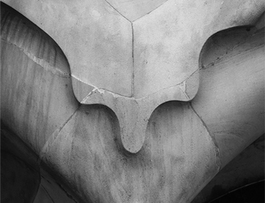
1."MODERNISME" AND THE "EIXAMPLE"
"Modernisme" represents the transition of Catalan architecture from the 19th to the 20th century, and was characterised by the elevation of concepts of innovation, nature and decoration to their maximum expression. "Modernisme” formed part of the European Art Nouveau movement, which signalled a new era in all artistic disciplines and became a central architectural movement, leaving us some of the masterpieces of world architecture of all times. In Barcelona, the principal architects of "Modernisme" - Antoni Gaudí, Josep Puig i Cadafalch, Lluís Domenech i Muntaner and Josep Maria Jujol - made a unique contribution to the city.
In the company of architects who are experts on Barcelona, we shall visit the much-photographed, incomparable works of the "Eixample" district, built according to the "Pla Cerdà", the city expansion plan which pioneered modern urban planning and was of key importance for the city of Barcelona.
*** The visit offers the possibility of visiting the interior of buildings open to the public. For this, 72-hour advance booking is essential.

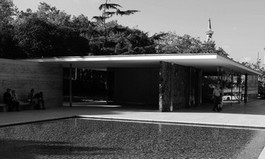
2. MONTJUÏC: SERT, MIES VAN DER ROHE AND RICHARD ROGERS
The panoramic view of Barcelona from Montjuïc enables us to understand the urban evolution of the city since the creation of the Roman city of Barcino.
The "Eixample" in 1859, the Universal Exhibitions of 1888 and 1929, and the Olympic Games in 1992 mark turning points in the transformation of Barcelona since the 19th century, as can be clearly seen from the hill.
The rationalism of the German pavilion, by Mies van der Rohe, coexists with structures and buildings as iconic as the CaixaForum art centre (installed in one of the most important examples of Catalan "modernista" industrial architecture, the Casaramona textile factory), the National Museum of Catalan Art (MNAC), the Greek Theatre, the Olympic Ring (which includes the architecture and the roof of the Palau Sant Jordi and the Telecommunications Tower), and the new shopping centre that Richard Rogers and Alonso-Balaguer installed in the former Las Arenas bullring).
The Miró Fundacion deserves a separate mention, as an exceptional coming-together of the work of two masters: the architect Josep Lluís Sert and the painter Joan Miró.


3. CONTEMPORARY ARCHITECTURE: 22@ AND FORUM, THE TRANSFORMATION OF AN INDUSTRIAL DISTRICT
The approval of Plan 22@ in the year 2000 was the start of one of the most important economic interventions of the 21st century in Catalonia, an urban renewal that constructed a new city model. Two hundred hectares of industrial land in the Poblenou district were transformed into green spaces and modern installations for the strategic concentration of intensive activities of technology, communication and information. The preservation of the industrial heritage and the commitment to innovative works by contemporary architects allow us to enjoy a special vision of 21st century Barcelona.
In 2004, on the occasion of the Universal Forum of Cultures, 30 hectares of beach were covered between the Olympic Port and Sant Adrià del Besòs, thus culminating the programme of urban regeneration that had started with the 1992 Olympic Games.


4. THE GOTHIC QUARTER, THE RIBERA AND THE BORN
The Gothic Quarter is the centre of old Barcelona. A maze of narrow streets, within the former Roman walls of the city, leads us to charming squares, quiet areas, the Gothic Cathedral and new projects.
The Palau de la Música (a "modernista" jewel), Santa Caterina Market (EMBT; once a Dominican convent), the imposing beauty of Santa Maria del Mar, the cathedral built by the fishermen's quarter, the Passeig del Born, scene of medieval celebrations in its day, later central market, and currently a key zone of leisure, design and the avant-garde.
Our tour reveals to the visitor that the Gothic Quarter of Barcelona is a clear demonstration that the coexistence between medieval urban heritage and modern buildings is perfectly possible. History and contemporaneity enliven a neighbourhood that has never lost its characteristic warmth and humanity.

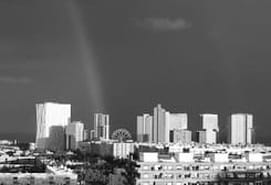
5. NEW SEA FRONT AND COASTAL SKYLINE
Barcelona and sea are synonymous. To speak of Barcelona is to invoke the Mediterranean; to invoke the Mediterranean is to speak of Barcelona. However, Barcelona has only faced the sea since the 1992 Olympic Games, thus recovering its natural relationship with the sea that bathes its beaches.
Until 1850, the city's only expansion outside its walls had given rise to the fishing district of Barceloneta, with its historic beaches. Thanks to the urban development spurred by the holding of the Olympic Games in Barcelona in 1992, the city gained new beaches and extended its sea front, by constructing the Olympic Village in an industrial zone that had become obsolete, the district of Poblenou, currently continuing its development below the Torre Agbar, an area which has become the flagship of the most advanced companies in technology and communications in southern Europe.


6. GREEN ARCHITECTURE – BESÒS AND LLOBREGAT
The green lung of the city. Air that gives respite, leisure and exercise to the citizens of Barcelona.
On this route we will cross the main green spaces of the city, although we will thoroughly analyse the linear systems and corridors of the city which are of great importance for the whole metropolitan area.
In particular, we will travel along and examine the two rivers of the city of Barcelona, and discuss the operations related to them that have been carried out during recent years. The fauna, flora, and historical and architectural heritage will be fundamental points of focus during the tour.

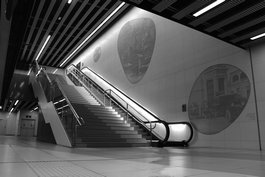
7. BARCELONA – INFRASTRUCTURES
The indisputable importance of infrastructures in the development and operation of a city make it necessary to offer the visitor to Barcelona an opportunity to learn about the infrastructures of a city that, among many other things, stands out for its extensive and efficient public transport network. This itinerary will discover underground Barcelona, as well as the main road infrastructures for public and private transport, interchanges and accesses, the metro, tram and train lines, ring roads and main city arteries. The objective is to learn about what the citizens of Barcelona experience on a daily basis. The relationship between urban importance and the time of implementation enables a vision of Barcelona from a very different perspective.

8. "COLONIAS" ALONG THE LLOBREGAT
A route taking in the Catalan textile factory "colonias", or model villages, in order to understand a vital moment in the evolution of social responsibility in industry and the conception of hierarchical architectures.
The route of 32 kilometers introduces us to the 18 textile factory villages spread along the Llobregat river and allows us to compare historical examples of other model villages. The route culminates at the Güell Village, designed in part by Antoni Gaudí, in Santa Coloma de Cervelló, where we can appreciate and understand his work through one of his key buildings, the Güell Crypt (fundamental to an understanding of the Sagrada Familia).
For any questions feel free to contact us at
[email protected]




